The Model Mayhem interview: Brian Smith
For the past 30 years, Pulitzer Prize-winning photographer Brian Smith’s iconic portraits of famous celebrities, athletes and executives have been used in advertising, by corporations and have graced the covers and pages of hundreds of magazines, including Sports Illustrated, ESPN the Magazine, TIME, Forbes, New York Times Magazine, Elle and British GQ.
His first magazine photograph appeared in LIFE Magazine when Smith was a 20-year-old student at the University of Missouri. Five years later, Smith won the Pulitzer Prize for Spot News Photography for his photographs of the 1984 Los Angeles Olympic Games. He was again a finalist for the Pulitzer for his photographs of Haiti in Turmoil. His photograph of Greg Louganis hitting his head on the diving board at the 1988 Seoul Olympics won first place in both World Press Photo and the Pictures of the Year competition. See more of Brian’s work on his website, briansmith.com.
We recently talked to Brian about his incredible work and new book, “Secrets of Great Portrait Photography: Photographs of the Famous and Infamous.”
— MM Edu
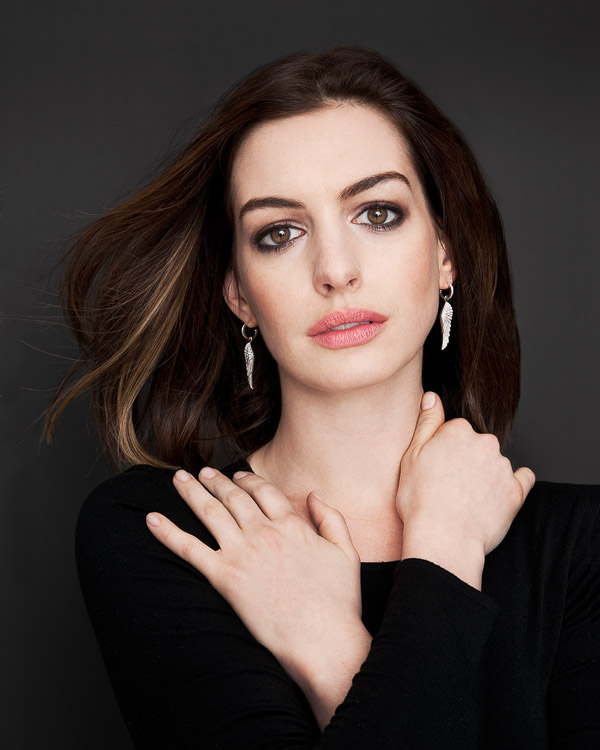
Anne Hathaway, photographed by Brian Smith in New York for Art & Soul
MM Edu: How did you get started as a photographer?
Brian Smith: I started off in high school shooting sports for the local newspaper. I was at the right place at the right time. I was on my high school swim team and the sports editor had to shoot his own photographs and he hated shooting swimming. I showed up one day with some of the pictures and he hired me on the spot.
MM Edu: Who most influenced your early work?
Brian: One of my first influences was Elliott Erwitt. The first photo book I ever bought was “The Private Experience: Elliott Erwitt.” It profiled his career and photographs. That book was the first glimpse of how professional photographers actually worked. In my hometown, the only guy who made his living from photography was the local portrait photographer. Elliott’s book showed me what else was possible so it had a huge influence on me.
I went to college at the University of Missouri. In addition to being the oldest journalism school in the country, they host the Pictures of Year competition and I got to meet and talk to the winners, which included Dave Burnett, Jodi Cobb and David Alan Harvey. Another huge influence was picking up the Columbian Tribune every day to see the work of great photographers like Bill Marr, David Griffin and Nick Kelsh.
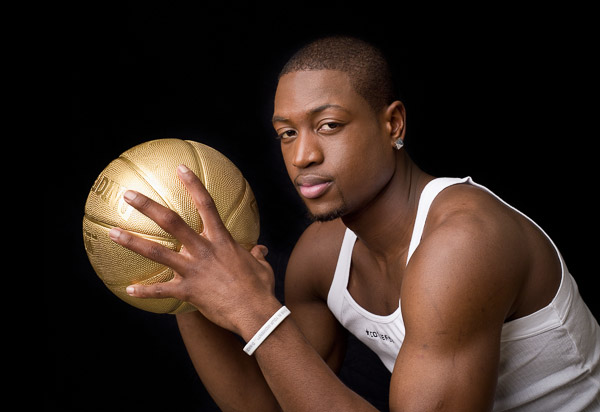
Dwyane Wade, photographed by Brian Smith at home for People magazine
“One of the greatest things about being a photographer is the opportunity to witness the world through your lens.”
MM Edu: You’ve won numerous awards, including a Pulitzer Prize at the age of 25. How did winning a Pulitzer change your life?
Brian Smith: In all honesty, shooting the Olympics was my dream, not winning a Pulitzer. The Olympics is truly the pinnacle of sport and one of the greatest events I’ve ever had a chance to photograph. Winning a Pulitzer doesn’t change your life, but it’s kind of like having a famous relative, it does open a few doors. It helped get me in the door to show my work to magazine photo editors. The ones who liked my work started hiring me. For the next six years, I juggled my full-time newspaper gig with all the magazine portrait assignments I could fit in.
MM Edu: Possibly your most famous shot is of Greg Louganis; tell us about that photo?
Brian Smith: It’s a bit ironic since it’s probably my best-known photograph, but I honestly never saw that one coming. I realize this makes me sound a bit like one of those cigar-chomping photographers with a speed graphic, but back in ’88 everyone was shooting with cameras that maxed out around 3.5 frames per second. Louganis was the defending Olympic Gold medalist and favorite to repeat, so every photographer was shooting that dive. I never saw the moment he hit his head because the viewfinder goes black the split second the mirror flips up. I just saw him splat into the water and I asked what happened. The entire pack of photographers replied in unison, “He HIT his head on the diving board.” At that moment I felt pretty good that I had the shot and they didn’t. It was quite simply the luck of the motor drive. Today at 10 fps, probably everyone would have gotten the shot.
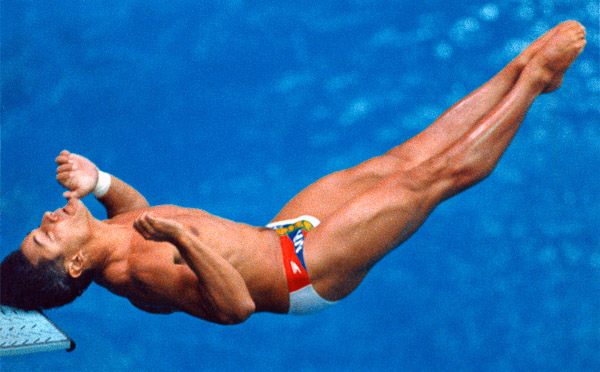
Greg Louganis, photographed by Brian Smith at the 1988 Seoul Olympics
“At that moment I felt pretty good that I had the shot and they didn’t.”
MM Edu: Despite your success, you went from journalism to portraiture. What inspired you to do that?
Brian: One of the greatest things about being a photographer is the opportunity to witness the world through your lens. In the 10 years I was a newspaper photographer, I covered everything from the Olympics to turmoil in Haiti to Super Bowls and I loved having a passport to witness these things. But at the same time I became increasingly drawn to portraiture. As much as I enjoyed shooting professional sports, I discovered that I really loved the opportunities to sit down with the athletes and spend time with them face-to-face instead of with a 600mm lens.
I think something about making a connection with someone else and learning something that maybe you didn’t know about someone. I’ve always enjoyed the opportunity to kind of drop into the lives of anyone, from photographing Bill Gates one day to a homeless man the next, and really learn about the whole range of people. I find it fascinating.

Bill Gates, photographed by Brian Smith in Atlanta for Business Week
“I’ve always enjoyed the opportunity to kind of drop into the lives of anyone, from photographing Bill Gates one day to a homeless man the next, and really learn about the whole range of people. I find it fascinating.”
MM Edu: What’s the biggest challenge with portrait photography?
Brian: I think the biggest challenge with this type of photography is time. I rarely have much time to get to know somebody—often I have less than 15 minutes—and you have to very quickly figure out the right approach to take with someone to make them comfortable and get them to open up. You have to take a very different approach if you’re shooting Bill Gates than Donald Trump. What works with one, would probably be a disaster for the other, and as I mentioned in the book, you have to be a 15-minute psychoanalyst of figuring out what makes different people tick and what’s the best approach to take to make them comfortable.
MM Edu: At the end of Chapter 1 you mention that as a photographer you should give everyone you shoot the star treatment, can you elaborate on that?
Brian: Absolutely. Although I’ve shot a lot of celebrities, sometimes I’m shooting someone who may be in the news for that particular week and it’s that classic Warhol quote where everyone is going to be famous for 15 minutes. If I’m photographing someone and it’s their first time in a national magazine like TIME, I realize that is their time in the spotlight and their opportunity. I think if you’re photographing someone, and it might be their first brush with a national magazine, that you want to make them feel like the star of their shoot and I think it’s true of anybody that you photograph.
I love photographing beautiful people that aren’t necessarily celebrities. I get as much of a kick photographing burlesque dancers or nudist golfers or anyone that’s comfortable in their own skin. I’ll give them the opportunity to be photographed.
It could be someone I’m shooting on the street, where I want them to know that I’m interested in photographing them because they’ve got a really interesting face. Whatever you can do to make whoever is in front of your lens feel special, it can only reflect well in the shoot; we all love attention, so if you can, anything you can do to make the person feel as if they’re the star of the shoot can really help.

Nude Golf, photographed by Brian Smith in Kissimmee, Florida for Sports Illustrated
“I love photographing beautiful people and they aren’t necessarily celebrities. I get as much of a kick photographing burlesque dancers or nudist golfers or anyone that’s comfortable in their own skin.”
MM Edu: In the book you give a lot of advice on how to pose people and that some shoots require a lot of control whereas in others you let the subject take over. How do you know which approach to take?
Brian: I think a lot of time you learn to pick up signs. Unlike the professional models at Model Mayhem, most of the people I photograph aren’t models, they are often uncomfortable in front of a camera and some absolutely hate it.
I usually start off with a pose that is natural for them. Rather than showing them a specific pose and expecting for them to create it, I tend to be very broad for what I ask somebody to do. It can be as simple as stand over here, lean against this wall, or can you lean forward a little bit, so that we start with what’s natural to them. Instead of showing them a gesture I might just ask if they can hold their hand closer to their face and see what they fall into naturally. If it looks good we start with that, if it needs to be adjusted I’ll work with them for something more comfortable that looks natural, and I continue to work with them to find what’s good for them.
There are times that you’re really lucky and have somebody that moves like a dancer in front of a camera and the only thing you have to do is be smart enough not to get in the way. I think that’s one of the keys, as well: knowing when to take over and when to stay out of your subjects’ way.
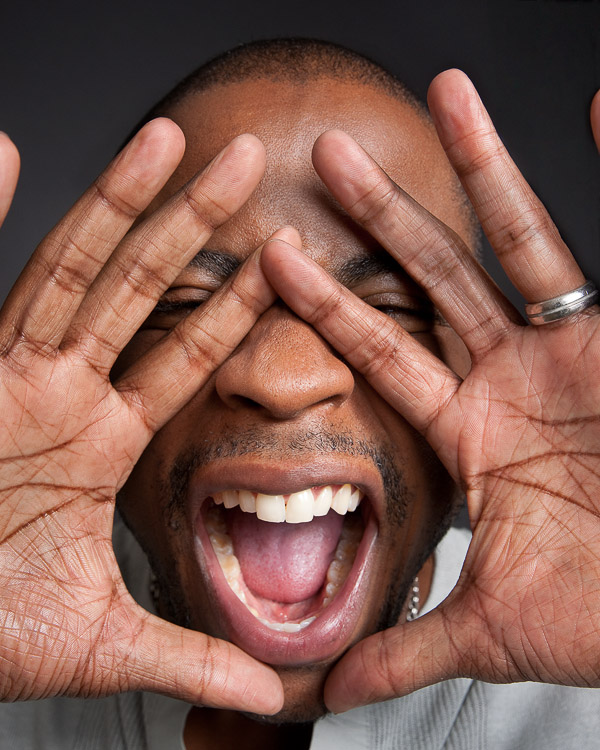
Dulé Hill, photographed by Brian Smith in Los Angeles for Art & Soul
“There are times that you’re really lucky and have somebody that moves like a dancer in front of a camera and the only thing you have to do is be smart enough not to get in the way.”
MM Edu: Time limitations seem to come up frequently and the need to improvise everything from the concept to location changes at the last minute. How much of what you do is planned versus improvised?
Brian: I think it’s always good to go in with a plan, whether it’s a concept or just an idea of what you want to shoot, but then it’s also important to remain flexible if it’s not working or your subject takes it in a different direction. It’s actually one of the things I learned while working on my previous book, “Art & Soul,” which featured portraits of 123 celebrities shot under the same lighting and under the same black background. It was really great learning experience because I was not able to do all the things I would normally do in the terms of location and concept. It really came down to them walking in, us talking for a couple of minutes and giving them a blank canvas to do whatever they wanted, but the results were better than I expected and it really taught me to be flexible. I still feel comfortable going in with a plan, but just leaving it to being in the moment and shooting something that expresses how they’re feeling that day. I’ve learned to not over-direct them.

Cindy Margolis, photographed by Brian Smith in Miami Beach for Entertainment Weekly
MM Edu: How many people are typically involved in your shoots?
Brian: It’s rarely just me, but it’s also rarely a huge team. Given magazine budgets these days, more and more often it’s a crew of two: me and my wife, Fazia Ali. She’s a stylist and makeup artist, so she pretty much does her thing and I do mine. It’s a great combination.
MM Edu: Fazia Ali is credited as “producer, stylist, wife and shrink.” How does she influence your work?
Brian: Well, I think she’s been a huge influence. She’s been a collaborator with me for the last 20+ years since we’ve been working together. I think the smartest thing a photographer can do is surround themselves with people who are brighter than they are and I think the more people you bring in with skills you don’t necessarily have—even just a couple people who see different things on a shoot—are so valuable. One of the most important things you can have is another set of eyes. Most of our shoots are collaborations.
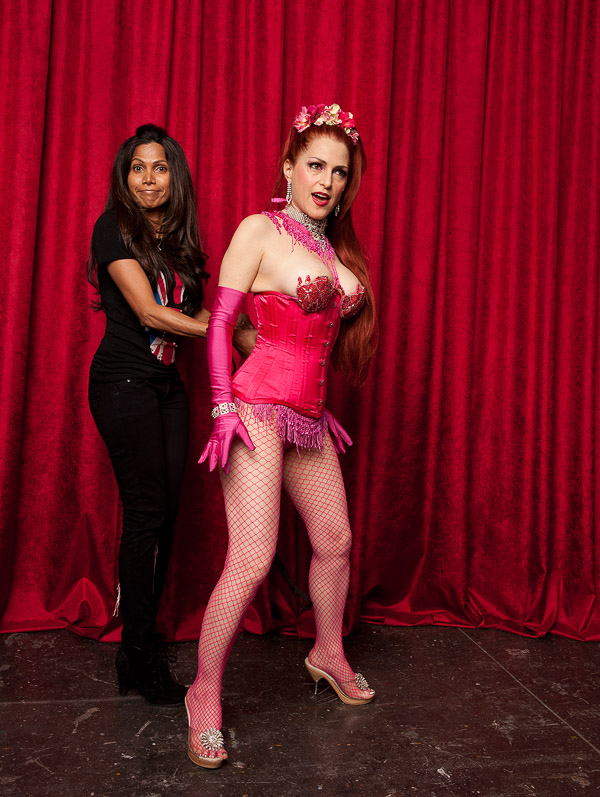
Fazia Ali, getting burlesque dancer Jo “Boobs” Wheldon ready for a shoot, photographed by Brian Smith
“The smartest thing a photographer can do is surround themselves with people who are brighter than they are and I think the more people you bring in with skills you don’t necessarily have—even just a couple people who see different things on a shoot—are so valuable.”
MM Edu: What advice would you give to beginners looking to develop a style and get into photography, particularly portrait photography?
Brian: One thing I would say about developing a style is don’t stress over it. I think there’s a lot of pressure to come up with a “certain look” and sometimes it’s better to sit back and let it come naturally to you. That’s kind of what I did; I never really put a huge emphasis on creating certain look that was a signature look. I just went out and shot and I think a lot of times the look we created was more dependent on the subject and reflective of what we’re trying to say about them based on the right approach for that subject, as opposed to a signature style that was about me. I think a lot of the style I’ve developed is more subject-driven, and I think that’s a really natural way to approach it. Other people noticed style in my work before I did, but for me it was mostly about the best approach for what I was shooting.
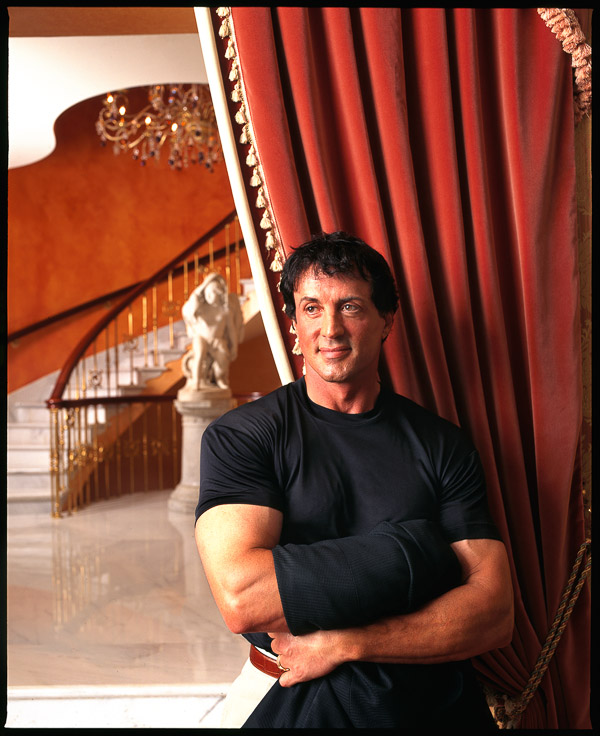
Sylvester Stallone, photographed by Brian Smith in Miami for The New York Times
MM Edu: With your body of work, it would have been easy to publish a collection or portraits or even a how-to but instead you focus on, “why are you taking this shot?” Can you explain that decision?
Brian: The whole premise behind the book was to write a book that I wish someone handed me 25 years ago. Many decisions were based on things that had been learning experiences for me—not when a photographer walks out and shows their spectacular amazing work and talks about how beautiful, spectacular and amazing they are, but when a photographer sits down and really explains why they do the things they do (such as why you’re drawn to certain lighting techniques, or the way that you photograph people). That’s what I’m curious about, even in terms of lighting I tried to explain why certain images were shot in a specific way. I didn’t want to just give an example where you put the light on the left side, and this is the power settings you use, and the exposure you use, because I found a lot of that stuff meaningless. To me, it’s not so much if you’re shooting at f/5.6 or f/11, it’s what you want to convey with that lighting. If you’re using soft lighting, why do you want it to be soft or why do you want it to be hard? Explain why that affects how the viewer feels about the image?
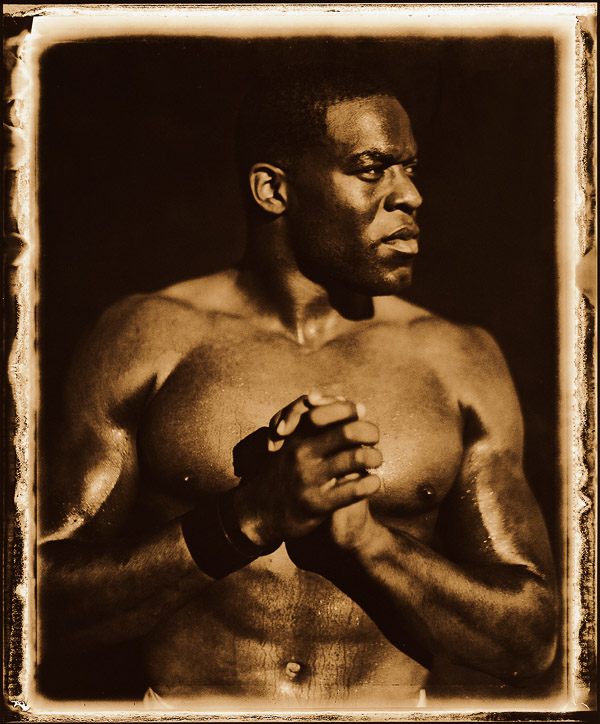
Simeon Rice, photographed by Brian Smith in Tampa for ESPN The Magazine
MM Edu: I think there’s tremendous value in sharing that kind of information, especially for less experienced photographers, but what about for those with more experience?
Brian: I made a gradual transition 10 years into my career from shooting news and sports to shooting portraiture and I had to figure out a lot of things at that point to really make that transition. So, it’s also aimed at accomplished photographers because we all want to improve or add to our skill sets. I’m always fascinated seeing how great product photographers or architecture photographers approach a project. I may not be doing what they do but I’m curious about the difference in their approach, as it might be vastly different from what I do, and I found that other photographers doing something quite different very fascinating.
MM Edu: Let’s turn to some of the specific subjects of your book. Do you have favorite or was there a particular shoot that stood out?
Brian: There are quite a few that I could mention. For an overall experience, our cover shot of Richard Branson is about as good a day as you could hope for as a magazine portrait photographer! We flew in the day before to his private island, were given a run of the place to scout wherever we liked. That night at dinner he asked me what I wanted to do. I responded that I had found a beautiful spot on the windswept beach that would look amazing at first light. He looked over and said, “Well, the sun comes up at 5:30 in the morning.” Before I could back-pedal and tell him that I could light it to “look” like first light if that was too early he said, “We need to be on the boat at 5 a.m.” When you have a billionaire going to his boat at 5 a.m., it’s pretty amazing! He was on-board with our concept and had already agreed to wear a space suit for a Time magazine article about Virgin Galactic space flights, and he could not have been better in front of a camera or more generous with his time and what we needed. So, that’s got to be pretty close to the top of my list and possibly only rivaled by our shoot of Anne Hathaway, simply because an hour with Anne Hathaway is really hard to top.

Sir Richard Branson, photographed by Brian Smith on Necker Island for TIME
MM Edu: What about the most challenging shoot you’ve had?
Brian: I think it really boils down to time. A lot of the people that I photograph are on very tight time schedules and it’s not unusual for me to have 15 minutes or even as little as 5 minutes with a person. I remember the first time I shot Jack Nicklaus he was coming off a golf course and I was photographing him for Fortune magazine. I was expecting to do something spectacular and he was in and out in one minute! I was thinking if I had anything at all that was publishable and I immediately called my editor to apologize. I was certain they expected so much more, but they were fairly used to this kind of thing and actually liked the photograph. And then to my absolute huge shock, when Jack wrote an autobiography a couple years later, his publisher licensed one of the photographs from that shoot for the cover of the book. I guess you never want to overlook what you can do in a minute. The result on that was certainly better than the experience.
MM Edu: Early on in your career you were advised to shoot 50 strangers and you pass that on in the book. How did it help you and why do you feel it was such valuable advice?
Brian: That really was the transition from when I had landed my first job shooting sports for the local newspaper and decided photography was going to be a great thing to do. I took a portfolio of these shots to the chief photographer of the largest newspaper in the state and he looked over everything and shook his head, then he said, “All this really tells me is that you can follow sports and focus a telephoto lens.” But he added, “If you really want to do this for a living you need to focus on shooting people.” He went on to say, “There is nothing I can hire you for here, but if you really want to do this go out and photograph 50 strangers, shoot a portrait of them that reveals something about who that person really is, and then come back to me.” It’s an exercise I have done many times throughout my career and it’s absolutely the best advice I have ever been given because so much of what I do in terms of learning how to deal with someone in the five minutes I have and putting them at ease and making them comfortable are things I learned going out and approaching strangers. It’s something I continue to do. I love taking portraits of people if I’m in India or Nepal, and as much as I’m drawn to beautiful landscape, there is something about the faces of the world that I’m drawn to. So without question that’s the best advice I’ve ever been given.
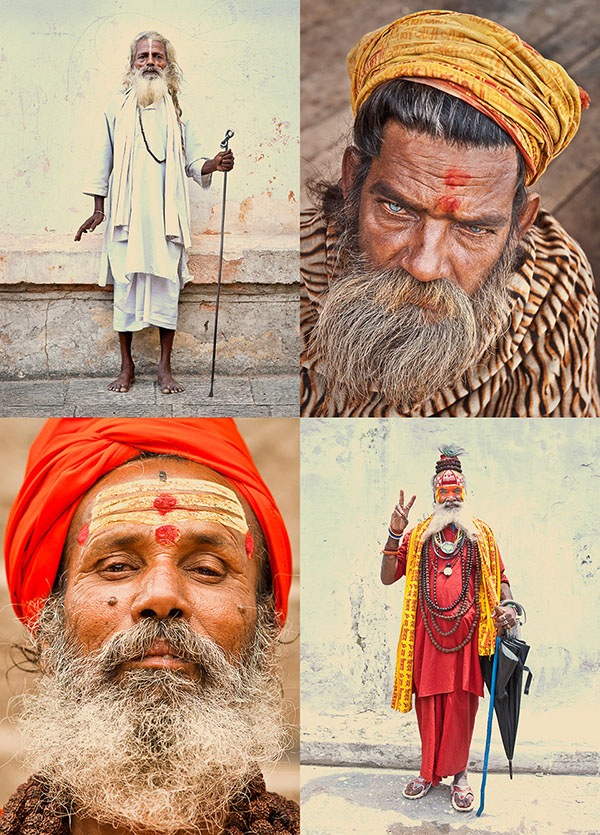
Holy Men of Nepal, photographed by Brian Smith in Kathmandu
“I love taking portraits of people if I’m in India or Nepal, and as much as I’m drawn to beautiful landscape, there is something about the faces of the world that I’m drawn to.”
MM Edu: It seems like you’ve shot anyone and everyone you could but is there anyone you wish you had the opportunity to shoot?
Brian: There are always a lot of people a portrait photographer is dying to shoot. I would say Usain Bolt is near the top of the list in terms of athletes. I’m fascinated with him and I would love to shoot with him. Not only for his tremendous athletic ability but when you watch him run and see the pure joy on his face, it’s somebody I’ve always wanted to shoot in the future.
MM Edu: You’ve achieved everything there is as a photographer, what’s next for you?
Brian: I think that every day you want to do what you really love and throughout your career just reach for something that you’ve never done before or improve on the work you’ve done. Like every photographer, I hope my best photos are still ahead of me.
MM Edu: I hope so too! Thanks for taking the time to chat with me today.
Brian: Thank you!
—
Brian’s latest book, Secrets of Great Portrait Photography: Photographs of the Famous and Infamous is available now.
Photos excerpted from Secrets of Great Portrait Photography: Photographs of the Famous and Infamous by Brian Smith. Copyright © 2013. Used with permission of Pearson Education, Inc. and New Riders.





January 02, 2014 at 12:06 am, Julian James Wilde said:
Excellent article. I look forward to seeing your Book!
November 16, 2012 at 9:54 pm, Isabel said:
He held a small gallery at my job at Books and Books in Coral Gables,Fl.
November 13, 2012 at 8:41 pm, LifeIsGreatImages said:
Thanks for sharing.
November 13, 2012 at 4:53 pm, dale pierce photography said:
reading brian’s observations and how he approaches a subject is a learning experience. Everyone brings something unique to the table.Thank you Brian for thinking of your comrades. Dale Pierce Photography
November 13, 2012 at 2:43 pm, Jess Viggoson said:
Hello Brian my name is Jessica and I am eighteen years old and I am very interested in modeling however, I am 5ft 5inches….and am unsure of where to begin. Any suggestions? Thank you.
November 13, 2012 at 4:06 pm, blammmb said:
With a portfolio.
November 13, 2012 at 4:07 pm, balmmmb said:
Then send it in to agencies with some of your best photos.
November 13, 2012 at 11:00 am, Altheah Ramos said:
Can I get a photoshoot done with you
November 10, 2012 at 2:33 am, Photo DeLux said:
Such an amazing interview, thank you so much… I found a genuine “gem” of insight in every thing he said! This is a fascinating interview of who Brian Smith is, where he came from and has been, how and why so many aspects of photography and “being a photographer” are important, and of course a sampling of the beautiful and varied collection of art seen through his lens. I’m definitely looking forward to the book!
November 09, 2012 at 4:09 pm, Mark Stout said:
I don’t see it mentioned here, but Brian is the President of Editorial Photographers, one of the professional associations working hard for photographers to protect our right to earn a living at what we do. He and the rest on the EP board have volunteered countless hours in our behalf. I highly recommend to anyone reading this article that you take a moment to go to http://editorialphoto.com/ and see the wealth of resources this group has available for you!
November 09, 2012 at 10:41 am, Peter Barron said:
What is Brian Smith’s MM number?